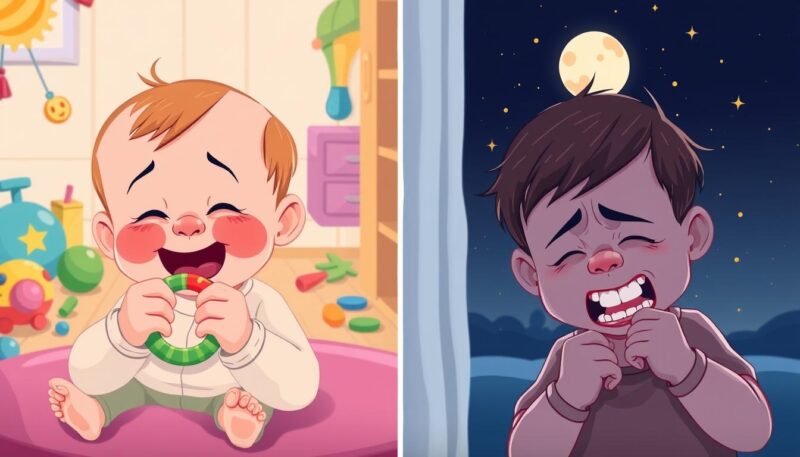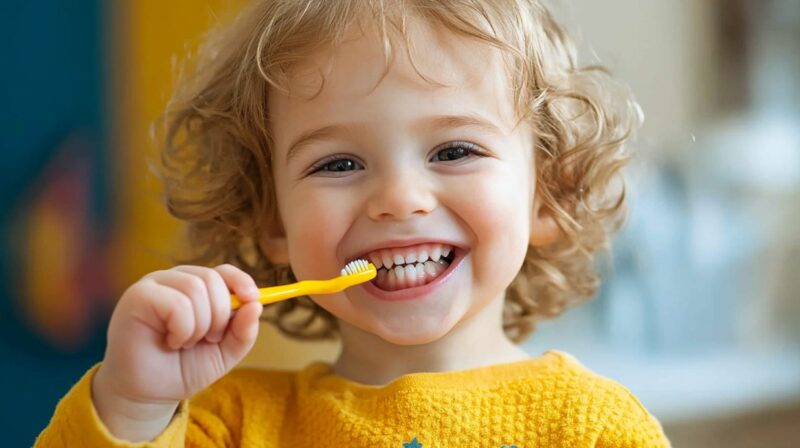As a parent, you might find yourself wondering, “why do toddlers grind their teeth?” Known clinically as bruxism, this behavior is surprisingly common, with estimates suggesting that 20% to 30% of young children grind or clench their teeth at some point in their early years. It’s not unusual for this habit to start as early as six months when that first tooth makes its appearance.
Another notable peak in toddler teeth grinding happens around age five, coinciding with the arrival of permanent teeth. While encountering bruxism in children can be alarming, there’s no need to panic; most toddlers will outgrow this habit without any intervention.
Bruxism usually manifests during sleep, but some children may also grind their teeth while they are awake. Parents often notice the sound of grinding at night, leading to concerns about potential damage to their toddler’s teeth. In fact, dentists often check for signs of wear and tear during check-ups, including chipped enamel or any indicators of habitual grinding. Although many children experience this issue, worrying statistics reveal that a percentage of them may experience headaches or facial pain as a direct result.
When it comes to solutions for bruxism, a majority of cases will not require treatment. However, in some situations where treatment becomes necessary, options such as using a night guard are available for older children. Unfortunately, this isn’t a feasible option for toddlers due to their rapidly changing dental structures.
Establishing a calming nighttime routine can also prove helpful, particularly if stress or anxiety is causing the grinding. Thus, understanding the causes behind this behavior is crucial, as some instances may simply be a phase that your little one will grow out of.
Understanding Toddlers and Teeth Grinding
Teeth grinding, medically referred to as bruxism, is a common phenomenon observed in children. This condition entails the involuntary grinding or clenching of teeth, often occurring during sleep. Studies indicate that anywhere between 6% and almost 50% of children may experience bruxism, especially while they are asleep.
Those affected might be completely unaware of their nighttime grinding habits. Most commonly, children aged 7 to 10 exhibit significant signs of teeth grinding, yet even infants can display this behavior when their teeth first emerge.
What is Bruxism?
Bruxism in children manifests as repetitive jaw movements leading to grinding or clenching. The precise causes of this condition remain uncertain; however, stress and anxiety often trigger episodes in toddlers. Research suggests that certain medical issues, including migraines and ADHD, might correlate with a higher incidence of bruxism.
Notably, boys tend to be more frequently affected by this condition, although further studies are necessary to solidify this connection. Dental issues in toddlers, such as misaligned teeth or the presence of braces, can exacerbate bruxism tendencies.
Signs That Your Toddler is Grinding Their Teeth
Recognizing the signs of teeth grinding is crucial for early intervention. Common indicators include:
- Clenching or grinding sounds during sleep
- Jaw pain or stiffness upon waking
- Increased sensitivity to hot or cold foods
- Chronic irritability or mood changes
- Fractured teeth or visible wear on enamel
Observing these signs can help parent understand and address potential dental issues toddlers may face due to bruxism. Recognizing these symptoms early allows parents to seek appropriate guidance for their children’s dental health.
| Signs of Teeth Grinding | Description |
|---|---|
| Clenching Sounds | Audible grinding noises during sleep. |
| Jaw Pain | Discomfort or soreness in the jaw upon waking. |
| Sensitivity | Heightened sensitivity to temperature in foods. |
| Irritability | Persistent irritability or behavioral changes. |
| Dental Damage | Visible wear or fractures on teeth. |
Why Do Toddlers Grind Their Teeth?
Understanding the reasons behind teeth grinding in toddlers can alleviate parental concerns. This behavior, known as bruxism, can stem from various factors. Recognizing these common teeth grinding causes can lead to better management strategies for your child’s oral health.
Common Causes of Teeth Grinding
Teeth grinding can manifest for reasons that are both physical and emotional. Key factors include:
- Teething: Many toddlers begin teething between 6 and 18 months, leading to discomfort that can trigger grinding.
- Stress and Teeth Grinding: Emotional stressors such as family transitions or changes in routine can heighten the likelihood of bruxism.
- Medical Conditions: Certain conditions like hyperactivity or cerebral palsy may contribute to the grinding behavior.
- Sleep Issues: Inadequate sleep often correlates with increased teeth grinding occurrences. The recommended duration for toddlers is no less than 12 hours per day.
- Dental Misalignment: Misaligned teeth might prompt your child to grind as a natural way to alleviate discomfort.
- Diet: Insufficient calcium intake or excessive sugar consumption can lead to greater susceptibility to dental problems and grinding.
Teething vs. Grinding: Key Differences
It’s essential for parents to distinguish between teething discomfort and grinding. Here are some clear distinctions:
| Teething | Grinding |
|---|---|
| Occurs typically during tooth eruption. | May start as early as 4 to 6 months, continuing into adulthood. |
| Characterized by irritability and drooling. | Leads to headaches and jaw pain linked to temporomandibular joint disorder (TMJ). |
| Discomfort usually resolves once teeth emerge. | Persistent grinding can cause tooth damage and decay over time. |
| Does not typically disrupt sleep. | Often occurs at night, especially during periods of stress. |

Recognizing these differences can help you respond appropriately to your child’s needs. Understanding the nuances of teeth grinding and teething will empower you to address any concerns effectively and promote better oral health habits in your family.
Conclusion
Teeth grinding, or bruxism, is a widespread issue affecting 20-30% of toddlers, primarily manifesting as nocturnal grinding. While this behavior often resolves itself without requiring significant intervention, it’s essential to monitor your child’s habits. Awareness of when to worry about grinding becomes critical, especially if you’re noticing frequent occurrences or signs of discomfort that may suggest dental problems.
If you’re concerned, consulting a dentist for toddlers can provide guidance tailored to your child’s specific needs. Possible solutions for bruxism include establishing calming bedtime routines or addressing any emotional stressors that might be contributing to the grinding. Understanding that anxiety from new situations, such as starting school, can lead to this behavior helps you provide the support your child may need.
Ultimately, keeping an eye on your toddler’s dental health and being proactive in seeking advice when necessary will ease your worries. By fostering a safe and calm environment, you can help promote good dental habits and reduce the likelihood of complications associated with bruxism.

